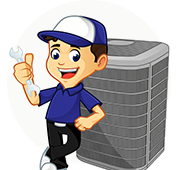
Nothing is more frustrating on a hot day than your AC blowing warm air. This common issue can stem from various causes, some of which are easy to fix, while others may require professional intervention. Here’s a guide to help you understand what it means when your AC is blowing warm air and what steps you can take to resolve the issue.
1. Thermostat Settings
Sometimes, the solution is as simple as checking your thermostat settings.
Tips:
- Ensure the thermostat is set to “cool” mode.
- Check if the temperature setting is lower than the current room temperature.
- Replace the thermostat batteries if needed.
2. Clogged Air Filter
A dirty or clogged air filter can restrict airflow, causing the system to overheat and blow warm air.
Tips:
- Inspect the air filter and replace it if it’s dirty. This should be done every 1 to 3 months.
- Regularly check and maintain the filter to ensure proper airflow and efficiency.
3. Refrigerant Leak
Refrigerant is essential for cooling the air in your AC unit. A leak can result in insufficient cooling.
Signs of a refrigerant leak:
- Ice buildup on the refrigerant line.
- Hissing or bubbling sounds near the AC unit.
- A noticeable decrease in cooling efficiency.
Solution:
- Contact a professional HVAC technician to inspect and repair the leak, and recharge the refrigerant.
4. Dirty Condenser Coils
The outdoor condenser unit can become clogged with dirt, debris, and leaves, preventing proper heat exchange and causing the AC to blow warm air.
Tips:
- Turn off the power to the unit.
- Clean the condenser coils using a garden hose, avoiding high pressure to prevent damage.
- Remove any debris surrounding the unit to ensure adequate airflow.
5. Faulty Compressor
The compressor is a critical component of your AC system, responsible for circulating refrigerant. If it’s malfunctioning, the system won’t cool properly.
Signs of a faulty compressor:
- Strange noises coming from the outdoor unit.
- The unit turns on but doesn’t cool.
- Frequent cycling on and off.
Solution:
- A faulty compressor typically requires professional repair or replacement.
6. Electrical Issues
Electrical problems can prevent the AC unit from functioning correctly, leading to warm air.
Common issues:
- Tripped circuit breakers or blown fuses.
- Loose or damaged wiring.
Solution:
- Reset the circuit breaker or replace blown fuses.
- Most wiring issues for HVAC can be done by an HVAC contractor, while more complex issues will require a professional electrician
7. Blocked or Closed Vents
Blocked or closed vents can restrict airflow, causing uneven cooling and potentially warm air.
Tips:
- Ensure all vents and registers are open and unobstructed.
- Check for any furniture or objects blocking the airflow.
8. Incorrect Size of AC Unit
An AC unit that is too small for your space can struggle to cool your home, leading to warm air.
Solution:
- Have a professional assess your home’s cooling needs and ensure you have the appropriately sized unit.
9. Evaporator Coil Issues
The evaporator coil inside your home absorbs heat from the air. If it’s frozen or dirty, it can’t do its job effectively.
Signs of evaporator coil issues:
- Ice buildup on the coil.
- Warm air blowing from the vents.
Solution:
- Turn off the AC to allow the coil to thaw if frozen.
- Contact a professional HVAC contractor to troubleshoot
Conclusion
If your AC is blowing warm air, it could be due to several reasons, ranging from simple thermostat settings to more complex issues like refrigerant leaks or compressor problems. Start by checking the basics, such as thermostat settings and air filters. If the problem persists, it’s best to contact a professional HVAC technician to diagnose and resolve the issue. Regular maintenance and timely repairs can help keep your AC system running efficiently, ensuring a cool and comfortable home during the hot summer months.

